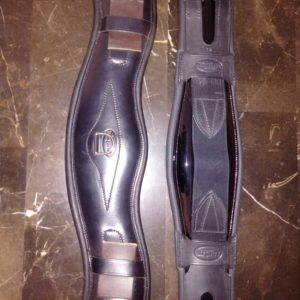First, it’s important to realize the wrong girth can seriously effect not only saddle fit, but horse comfort.
Let’s deal with saddle fit first.
When a saddle is fitted correctly, the billets will hang down parallel and in line with the front legs.
When the girth is applied and the girth sits in the girth groove just behind the elbow, the billets should line up with the buckles. Is it important to note when the saddle is girthed that the billets should remain perpendicular to the ground. If when girthed, the front billet is pulled at an angle forward, this may result in the saddle being pulled forward and into the horse’s shoulder. This indicates the horse has a forward girth line and dictates the need for an ergonomic girth as pictured that contoured forward under the sternum.

These girths are designed to fit forward into the sternum and come back around the elbow and help to keep the front billet straight and perpendicular stopping the saddle from being pulled forward and pinching the horse in the shoulder .
Clearly , if the saddle is being pulled forward into the shoulder, it will not only unbalance the saddle, it will impinge on the horses movement into the shoulder and put the riders weight into the loin rather than being balanced evenly through the horses back.
For the same reason, girth design and girth type can effect saddle movement. Girths should always have either elastic at BOTH ends or a center elastic. Remember, we are asking the horse to move through the ribcage and if the elastic is only on one side when the rib cage moves, the rib cage can only expand in the direction of the elastic in the girth. When the ribcage moves or tries to move on the side where there is no elastic, it can only do so by pulling the saddle to one side.
When no elastic is used, it is virtually impossible for the ribcage to move without pulling the saddle, It’s important not only for saddle fit but also for the horses comfort to have the correct girth. Using an elasticated girth also allows the ribs to expand and move the ribcage when he breathes without affecting the saddle. It improves the comfort of the horse and rider.
Can you have too much stretch in the elastic? Is there too much of a good thing? Most definitely…Having a girth with too much elastic can be as detrimental as a girth with no elastic. If it has too much give, it will allow the saddle to move too much as if your girth was too loose. So the elastic must be very sturdy without too much give.
Condition of the girth is also important. They should be cleaned and conditioned regularly to prevent from cracking or becoming extremely hard. The elastic should also be checked regularly to insure the serviceability of the elastic, but also that it hasn’t become over stretched. As elastic ages, the elastic stretches and will or can bring the buckles over the edge or top of the girth as you tighten creating pinching of the horses skin.
One should always tighten a girth in sequence moving form the rear billet first to the front billet and left to right.
It’s important to tighten the first by billet tentsion and not hole numbers so that the saddle is tightened evenly into the horses back. Remember the billets run at angles through the saddle and the horses barrel is not symmetrical thus, when tightened one should not expect the holes numbers to be even.
The reason for tightening the rear billet first is the rear billet will pull the saddle from the rear into the horses back freeing up the shoulder. If you tighten the front billet first rather than the rear, the front billet pulls the saddle downwards unbalancing the saddle into the trapezius. Thus you already not only are unbalancing your saddle, you are restricting the movement of the trapezius and it’s ability to pull through the longisimus.
It is also important to notice that many horses prefer to have their girth tightened slowly over time as you ride. However, it is very natural for the rider to lean forward in the saddle and tighten the girth while sitting on the horse. Invariably, always tightening the front billet first and driving it into the horses shoulder negating all the above we have tried to achieve.
Think about where your weight is when you do this. You have leaned forward and you are tightening the front billet which does exactly what you were trying to avoid when you girthed the saddle in the cross ties tightening the rear billet first .
Whenever possible, tighten the girth with help on the ground or dismount.
If neither is possible, try to stay balanced in the saddle and tighten the rear billet first.
You can speak with one of us or our N2 team if you have questions or concerns about girths. We do carry girths for sale which we have designed for optimal comfort and performance.